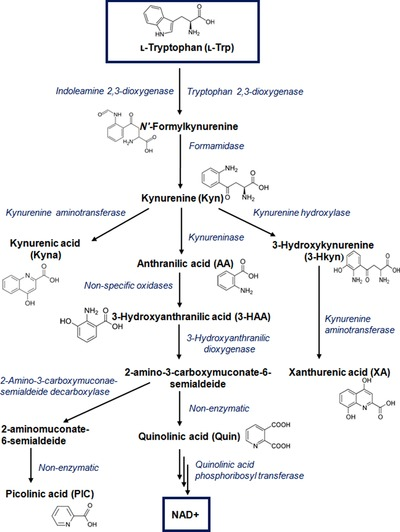v-innovate Technologies can provide method based on high performance liquid chromatography-tandem mass spectrometry (HPLC-MS/MS) technology and liquid chromatograph mass spectrometer (LC-MS) method to quickly determine the content of tryptophan and its metabolites in multiple sample types. It can obtain a high-quality analysis reports for the evaluation of tryptophan and its metabolite levels. Exploring the relationship between the change rule of tryptophan and its metabolites and biological processes is of great significance for the search for effective target markers, the diagnosis of related diseases, and disease monitoring.
Tryptophan is an essential amino acid for the human body. It participates in protein synthesis and is the precursor of many important biologically active molecules. Tryptophan metabolism plays an important role in maintaining the body's homeostasis. Tryptophan metabolic pathway may play an important role in the occurrence and development of many physiological disease. We use deuterated tryptophan as an internal standard to correct the matrix effect to a certain extent to improve the accuracy and reproducibility of quantitative analysis. The activated carbon adsorption method is used to adsorb and remove the endogenous tryptophan and its metabolites in the plasma, so that the matrix is closer to the original biological matrix, making it a substitute matrix for constructing a standard curve, and improving the accuracy of quantitative analysis results. We can also use LC-MS to obtain the content analysis of citrulline, and it provides high sensitivity for its detection.
 Figure 1. Scheme of ʟ-tryptophan metabolism via kynurenine pathway. (Sadok 2017).
Figure 1. Scheme of ʟ-tryptophan metabolism via kynurenine pathway. (Sadok 2017).
The peak shape obtained in the experiment is good, and the peaks of the target compound and the internal standard substance are not interfered by impurities or endogenous substances in the plasma. The sample pretreatment of this method is simple and convenient, the analysis time is short, and it has the advantage of high throughput, which is conducive to the determination of large sample volumes. Using deuterated tryptophan as an internal standard can reduce the errors caused by sample pretreatment and ionization to a certain extent. LC-MS is used for detection, quantitative analysis results of trace sample substances
 Figure 2. Tryptophan analysis service workflow.
Figure 2. Tryptophan analysis service workflow.
Detection method: standard curve method, internal standard method
Mobile phase: ultrapure water and methanol (v/v, 45/55) containing 0.2% formic acid and 5 mmol/l ammonium acetate
Injection volume: 4 μl
Flow rate: 0.3 ml/min
Elution mode: isocratic elution
Analysis time: 3 min
Reactive ion: positive ion electrospray ionization (ESI)
Monitoring mode: Multi-reaction monitoring mode
Electrospray voltage: 5500 V
Curtain air pressure: 25 psi
Atomizing gas pressure: 50 psi
Auxiliary gas pressure: 50psi
Precision (RSD): ≤ 20%
Average recovery rate: 108.40%
Average matrix effect: 83.55%
Number of biological replicates: At least 6 biological replicates for plant samples, and at least 10 biological replicates for animal samples
The samples include multiple sample types such as animals, plants and microorganisms, please contact us for details.
We use high performance liquid chromatography-tandem mass spectrometry and LC-MS method to establish a simple, fast, sensitive, and low sample consumption method for the accurate quantitative determination of tryptophan and its metabolites. v-innovate Technologies wholeheartedly provide you with stable and reliable analysis tools to meet your diverse analysis needs.
References
